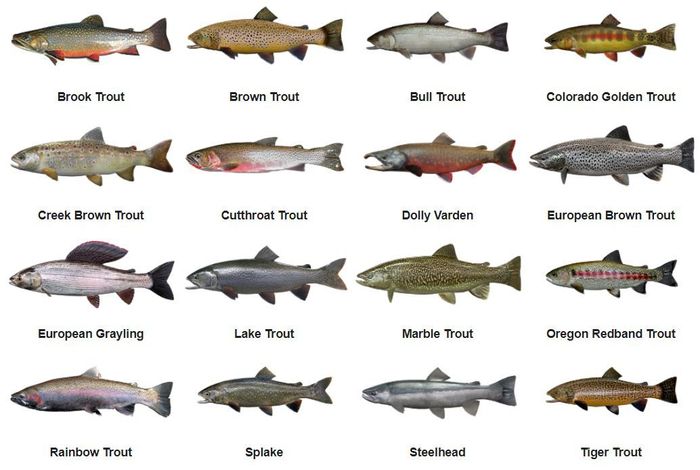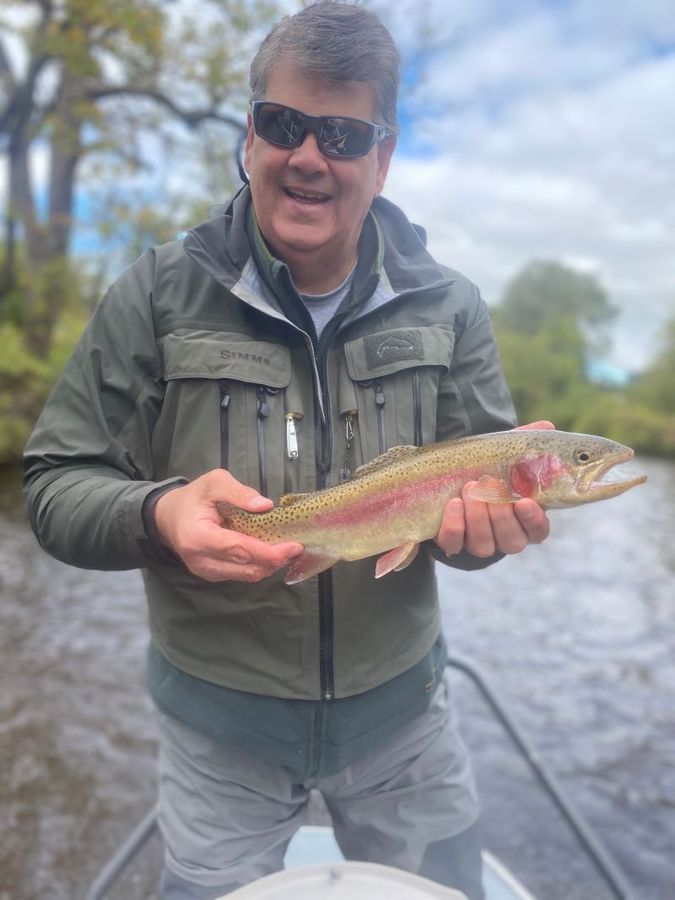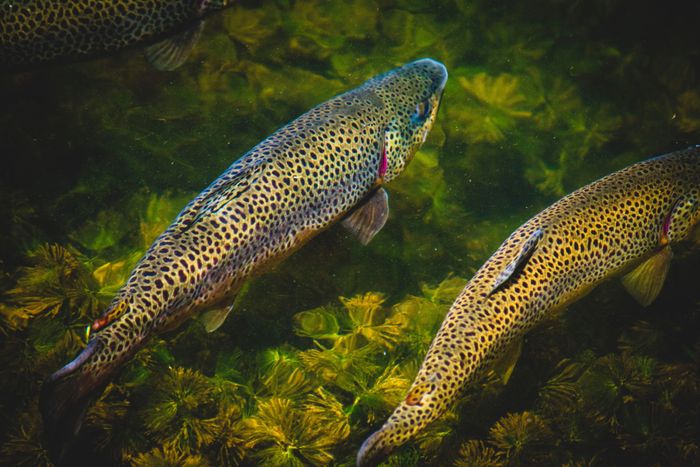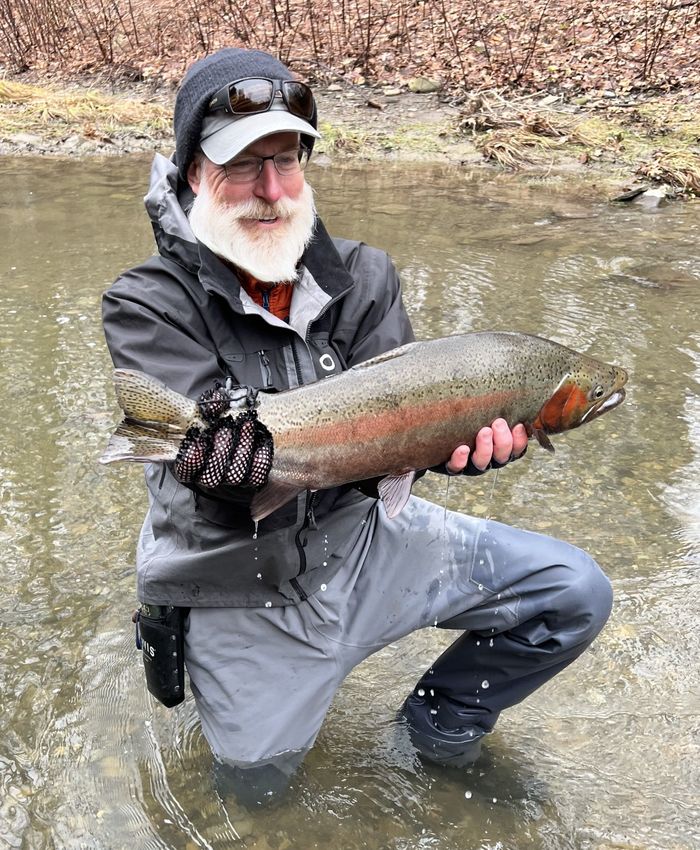Big 10 Trout of North America
The biggest and baddest trout of North America. Find our top 10 list about these trout species- who are the natives, invaders, chars and more.

Trout of North America
Trout is one of the most delicious freshwater fish commonly caught by sport anglers, although not the biggest fish available in many rivers and lakes, it can still be a rewarding catch due to its popularity as a game fish in many parts of the world. North America is home to different species of trout. Some of them are native, some are crossbreed, and some are invaders. All of these species present a different challenge, and they are of importance to the angler. But maybe the important part of it is that these native species belong in America. They are a natural and valuable part of America's natural environment.

With so many species of trout waiting to be fished in North American water. It may surprise you to know that some prominent species, like brown trout, are not from our environment. Although brown trout are widespread all over America, they are not native to our continent. So, in this article, we will take a look at the big 10 trout of North America. It will be to your benefit to know more about these fish, their habitats, and how to differentiate one from another. Without further ado, let's begin with the Pacific Trout.
The Natives: Pacific Trout
These are among the most sought-after game fish in North American water, they are fun to catch and delicious to eat, and they are really clever and crafty. There are three species of Pacific trout in North America, but each fish varies greatly depending on where they are caught.

1. Rainbow Trout (Oncorhynchus mykiss)
Rainbow trout are the most common sportfish in North America. Native to the west coast, Alaska, and British Columbia, but now can be found in streams and lakes throughout North America. Rainbows are the most common hatchery fish and are stocked throughout the United States. They have a pinkish band extended along the side of their bodies; rainbows are spectacular with their colorful presentation, the stylish pink stripe giving way to a silver underneath that fades to pearly white. There are also some small black spots on their back, fins, and tail.

Rainbow trout coloration varies mainly with respect to their habitat, age, gender, and spawning conditions. Their fins lack spines. There is a little triangular projection around the base of their pelvic fin. And their tail fin is definitely forked, and the anal fins generally have 10 or 11 rays.
2. Cutthroat Trout (Oncorhynchus clarkii)
This fish is known by many names like Yellowstone, Salmo clarki, Clark's trout, etc. There are different varieties of Cutthroat trout, though the most common ones are the Snake River Cutthroat, Yellowstone Cutthroat, and Coastal Cutthroat. They have amazing colors; one characteristic of cutthroat trout is that it has two orange-red or yellow markings on the lower jaw side. The coastal cutthroat is dark green and has black spots with silvery sides. And Yellowstone cutthroat is different. It has a green or yellow body. The sides of the head and the front of the fish body, and the abdomen are red in color. Cutthroat trout are popular for their tendency to rise to dry flies freely; this makes them exceptional sport fish. They are ocean migratory fish and spawn from February to May. When you come across a cutthroat trout, you will know it is cutthroat with various characteristics. Their head is blunt with a long jaw that extends beyond the eyes. Cutthroat trout fishing is popular around the world. This is because they don't allow you to catch them easily. You will have to battle to reel the fish in, and once you land it you will be amazed by the rich orange-red colored flesh.
3. Golden Trout (Oncorhynchus aguabonita)
Golden trout is another North American native trout. They are rare and beautiful mountain fish. They live in some of the most remote lakes and trout streams in the United States. They are the smallest types of the trout family, and as the name implies, they have a golden color and orange-red stripes on the side. They have limited range because they are only found in high alpine lakes and streams in the Rocky Mountains and the Cascades. They have scattering black spots and a red striping along with their lateral line, stomach, and gill plates. They feed on surface insect and small crustaceans such as freshwater terrestrial insects. Because of the shortage of insects during the winter season, golden trout have a specific spawning season, which begins in May and ends in September. And because they are not very common, it is suggested that anglers who catch them release them instead of eating them.
The Invaders: European Trout
Ecosystems across the world have changed dramatically as fish species are moved around, it's obvious that some species move from their native habitat to a new environment. A good example of such species is the brown trout, this species originates from Europe, but today it can be found universally. Brown trout are found all over the world on several continents, including South America, Africa, Europe, and North America.

1. Brown Trout (Salmo trutta)

Brown Trout originated from Northern Europe and were brought to North America in the early 20th century, they are known as brown Trout for their yellowish-brown color dotted with orange, red, and black spots on their sites. They can grow up to 12 inches long and beyond that in a rare case. Brown trout will swim to the bottom of the water and hide among vegetation and rocks. They can be found in the Midwest, including the eastern and western parts of the United States. Brown trout spawn in cold water in the fall and their eggs hatches during spring. With the exception of the spawning season, brown trout usually locate themselves in warm water, especially at temperatures around 65 degrees.
If you are looking for an easy catch, you perhaps will not achieve this goal by fishing brown trout. These sneaky fish don't swim around much; they prefer to stay in underwater hiding places. Though, they are not impossible to catch, and catching them can mean a terrific battle because they are so big and will put on a real fight when hooked.
2. The Chars: Char Trout (Salvelinus)
It may be a little complicated here because there are few species of trout in North America that are not truly trout. Char trout is a member of the salmon family found in the cold waters of the Arctic and some deep mountain lakes in Europe and Canada. They are closely related to trout and salmon but vary in appearance. While salmon and trout have black spots on a light background, char has light spots on a dark background. Compared to trout and salmon, char is more cold-water fish with an optimum temperature of between 50 degrees Fahrenheit and 57 degrees Fahrenheit. In North America, there are five types of char: brook trout, Dolly Varden, lake trout, Arctic char, and bull trout.
3. Brook Trout (Salvelinus fontinalis)
Brook trout have square tails with very fine scales. Their body starts out dark at the top and gradually becomes lighter even before their belly turns white. Their stomach is usually reddish or bright orange in color. They are also referred to as speckled trout; this is the most beautiful type of trout. Their image shows that they have white leading edges and are backed by black color on the lower fins. Also, they have yellow spots on their back, which spread to form worm-like shapes. On both sides, their color changes from olive to orange or red, with separate spots that make them almost similar to red trout. They measure between 9-10 inches long.
4. Bull Trout (Salvelinus confluentus)
These are rare species of trout, originally found all over the Pacific Northwest and the Rocky Mountains. They are native to Canada, and their geographic range is confined to North America from Alaska to northern California. They inhabit Pacific waters, Arctic water, and the Missouri River drainages in coastal streams and mountains. Bull trout are a fragile species and are mainly catch and release fish. They may live close to areas where they can migrate or spawn from small streams to larger streams and rivers. Smaller ones stay close to spawning areas, while larger ones move great distances to spawn when habitat conditions allow. Spawning is important to keep them healthy.
5. Lake Trout (Salvelinus namaycush)
Lake trout is a deep-water fish found in glacial reservoirs and lakes of northern America. The fish is a char of similar species as Bull Trout; they are native to the coldwater lakes in northern parts of North America. They are the major game fish in Canada. They are rare in water deeper than 20 feet except when spawning. Lake Trout are best caught with spoons and jigs fished in deep water. They are highly prized food in Canada. Just like other chars, they have light spotting on a dark background, and they can be distinguished from other chars by their deeply forked tail.
The Travelers: Migratory Trout
1. Steelhead Trout (Oncorhynchus mykiss)

Steelhead trout, also known as North American steelhead, are a prized game fish that can be found in many of the major rivers and streams across the western United States. They are closely related to rainbow trout and are often referred to as sea-run rainbows due to their anadromous nature. Steelhead typically spend 2-3 years in freshwater before migrating out to the ocean where they will grow rapidly before returning back upriver to spawn.
These fish are highly sought after by anglers for their beautiful coloration, acrobatic fighting style, and delicious taste. Steelhead have distinctive, silvery sides with a blue-green back and black spots along their body. They can range in size from just a few pounds up to 30 or more, depending on age and location.
2. Sea-Run Trout (Salmo trutta)
This is one of the most widely distributed non-native fish in North America. They were moved from Puerto Montt in Chile; about 60,000 eggs survived the difficult journey and were planted on the Candelaria and McLennan rivers, tributaries of Rio Grande. Attracted by the rich food supply, the fish finally reached the sea. When fishing for sea runs, try to start at the point of the stream or river where the water turns brackish. The best areas are those with a gravel bottom. If the water has a fish ladder, this is a great place to explore. They may even venture along saltwater shorelines when chasing schools of lures. Although they do not migrate like salmon, they will venture into saltwater and come back to their relatively safe havens in the rivers.
The Crossovers: Hybrid Trout
If you are questioning whether fish can be a crossbreed, the short answer is yes, fish can be a crossbreed. Over the years, crossbreeding has allowed humans to create a new group of fish. There are a few hybrid trout that you can find in North American waters. Although the chance of hooking any of these species in the wild is low, however, it's always good to know them, just in case. So, the following are the three kinds of hybrid trout in North America.
1. Tiger Trout (Salmo trutta x Salvelinus fontinalis)
Tiger trout is a type of fish that is born due to cross-breeding brook trout with brown trout. The crossing process occurs when the male sperm is fertilized by the female trout. The female is a little more lackluster in color compared to the male tiger trout. The females tend to be tan and light brown, with fewer orange and yellow tones. They thrive in cold water environments, particularly in lakes. Tiger trout does well in water that has enough aquatic vegetation, like freshwater algae. They have a grayish-brown body that is covered with a dark pattern that resembles a labyrinth. Tiger trout has a square tail fin and a bright belly that is a blend of orange and yellow. Their pelvic and pectoral fins are similar colors to their belly.
2. Apache Trout (Oncorhynchus gilae apache)
Apache Trout is one of the two native Arizona trout. And they are known as the Arizona State fish and have historically been found only at the headwaters of Little Colorado Rivers at more than 5,900 feet. Apache trout has a yellowish-gold color with a golden belly and medium-sized dark spots that are equally spaced and may extend below the lateral line and onto the tail fins. They can grow up to 20 inches, but most grow to only 9 inches due to the smaller streams they live in. They generally spawn during winter and early spring. Apache trout can interbreed with rainbow trout, which greatly reduces the variety of pure stocks of Apaches.
Conclusion
North America is called "The Trout Paradise" by many fishing enthusiasts. If you have the stamina to go for a sea adventure, then North America water is the right place for you. With the above list of trout in North America, it's not surprising that anglers say North America is a trout fishing haven. All these trout species are native to North American water, and they are an important occupant in our streams. Though some of them may have extra sporting value than others, the important thing is to respect and work to protect all of them. Lastly, the following is the summary of what we cover here; in general, there are ten species of trout in North America:
- Three Pacific Trouts: Rainbow Trout, Cutthroat Trout, Golden Trout
- One European Trout: Brown Trout
- Three Chars: Brook Trout, Bull Trout, Lake Trout
- Travelers: Steelhead Trout, Sea-Run Trout
- Three known Hybrids: Tiger Trout, Apache Trout


